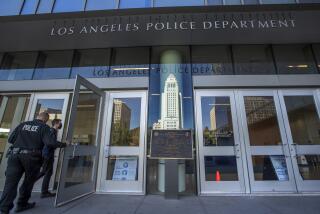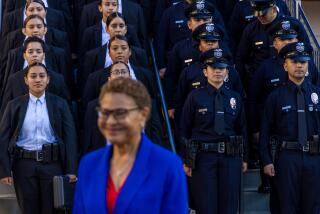PERSPECTIVE ON THE LAPD : A Simple Time, in Black and White : In the ‘50s, racism was an enforcement tool passed down from a chief who was god to a legion of Fuhrmans.
- Share via
Back in the late Middle Ages when I came on the job (1959), the Los Angeles Police Department was completely segregated and by any definition extremely racist. Dwight D. Eisenhower was President and Chief William H. Parker was god. Daryl Gates was a sergeant in the chief’s office and Tom Bradley was a lieutenant out in the Wilshire Division.
In the old University Division (now Southwest), the police were a benevolent paternalistic presence feared by all. The African American officers, known as Negroes, were always assigned together, and if one partner was off, the other would work the desk or take the day off, too. The Negro teams were respected by the white officers but were utilized in patronizing ways. The most common radio call was for a family dispute, and “see the woman, unknown trouble,” was the most feared summons. Officers were required to be family relations counselors in a culture as foreign to most of us as an enclave of Martians.
We were a mercenary army unofficially empowered to arrest anyone at any time for any cause. The most common was drunkenness or drinking in public view, but more exotic charges could always be approved by the detectives on probable cause. At every roll call, officers were required to record in their notebooks a string of recent robbery or burglary reports in which suspects were usually described as male Negroes, 25 to 30 years old, average height and weight, black hair and brown eyes. Sometimes the descriptions were refined to include porkpie hats or processed hair, but still, any report could describe half of the men in the division’s area.
Heroin addiction was a big problem in the division’s area and officers were under orders to book any “hype” (addict) that they saw. Fresh needle tracks meant an instant felony arrest and made for nice month-end recaps. Another easy felony arrest was a marijuana cigarette, and many careless smokers with a roach in plain view spent the night in the division jail. The night watch jailer was the vice principal of Manual Arts High School in the daytime, and he gave many youths a double dose of paternalistic oppression.
The common complaint was that we were required to be social workers and deal with problems such as drug use and “immoral” sexual activity. Some of the things that people went to jail for and suffered at the hands of the police are now legal and accepted. It was illegal to masquerade as the opposite sex. It was also illegal for persons of the same sex to dance with one another.
The streetwalkers around Adams and Western were all black females--no one saw a transvestite in those days, much less a transsexual. The rules were pretty strict and officers had to hear a solicitation to make an arrest, but there were some old Municipal Code ordinances that could be used, ancient and shaky as they might be. “Vagrancy with intent to commit prostitution, vagrancy with intent to commit lewd acts” and the ever-popular “resorting for purposes of prostitution” (when two people not married to each other meet for sex) were commonly cited misdemeanors. Oral copulation was a felony and woe to the prostitute and customer caught in the act. The police often caused the arrest of people who were not involved in prostitution but simply not married to one another.
Black people could not venture north of Beverly or much west of La Brea after dark without a strongly documented purpose. In Hollywood Division, a Negro was an automatic “shake” or field interview with the resultant warrant check or match-up to some vague crime report. A favored location for these shakes was the call box at Outpost Canyon and Mulholland Drive. If there was absolutely no way to arrest the suspect, he was told to start walking.
The turning point in these racist traditions came in 1960. During his presidential campaign, John F. Kennedy promised equality for Negroes. The Democratic National Convention was held in the new Sports Arena next to the Coliseum in the heart of University Division. Kennedy was brought in every day in a police-escorted caravan, red lights and sirens. The rumors were that he had promised to make Chief Parker the head of the FBI or some other federal office if elected.
The department tried to integrate but it was a battle. White officers would walk up to the lieutenant’s desk and throw down their badges rather than work with a Negro. These bluffs were almost always reconciled with quiet reason, but no adamant refusal was challenged--there weren’t that many black officers to be paired with anyway.
The city’s first race riots were at the Griffith Park merry-go-round in 1962 and 1963. The black youths of South-Central were told that they could enjoy the city parks freely, and they came by the busload on weekends and mixed with white citizens. This caused a lot of friction, and where there is enough friction, there is a fire. Black officers were brought in--just loaned, not transferred to the Hollywood Division--to help. There were as many problems getting the old Hollywood officers to work with blacks as there were with dealing with the flare-ups at the merry-go-round.
More fuel for the fires came from the black Muslims, who believed that they were God’s chosen people and were as racist toward whites as George Wallace was toward blacks. The Muslim troops had no fear and an attitude of religious dedication to their cause of black supremacy. Their neat black suits and close-shaven heads were a direct challenge to racist cops--and even to fairer-minded officers. And don’t forget the Black Panthers who pursued their cause by shooting at us.
The civil unrest of the ‘60s was anathema to the conservative cops under the direction of Chief Parker. The department was largely made up of white men who had fought in World War II and Korea, honorable wars for honorable causes. The communist threat was the cloud that hung over our country, and it was represented by civil libertarians who were marching, demonstrating and protesting on our streets. Once, when I was working undercover at a demonstration for some innocuous cause, I got thumped pretty good by a uniformed officer with an old hickory baton. It sure hurt and gave me just a glimmer of insight into what some people had to live with every day of their lives, just for thinking differently than we did or, worse yet, for just looking different.
Search and seizure laws had only recently been tightened by Supreme Court decisions and were decried as the end of police power. There were no Miranda or Escobedo rules for interrogation, and we used to laugh at British movie detectives with their exhortations of remaining silent.
The way to get ahead in the department was to go along--not necessarily to condone misconduct; just don’t challenge the conventional wisdom, no matter how misguided it might be. Even better, find statistics and write reports justifying the status quo. A militant of any persuasion would not go too far in the department. The few exceptions who concealed their proclivities in the ranks usually became brilliant leaders. A black man could work motorcycle patrol, command the elite Metropolitan Division and rise to deputy chief, but he had to be kind of white to get there. After he retired, he could be as black as he wanted to be and become mayor or police commissioner, but the department would consider him a racist turncoat.
Officers like Mark Fuhrman may be aberrations in the 1990s, but they were common in the ‘50s and some stayed until the ‘80s, passing on their infinite ignorance to the more suggestible followers on the force. Naive arrogance in high places was blind to racism but contributed much to the worship of a ‘50s chief who usually referred to black people as “nigras,” and you know what that sounds like.
More to Read
Sign up for Essential California
The most important California stories and recommendations in your inbox every morning.
You may occasionally receive promotional content from the Los Angeles Times.










